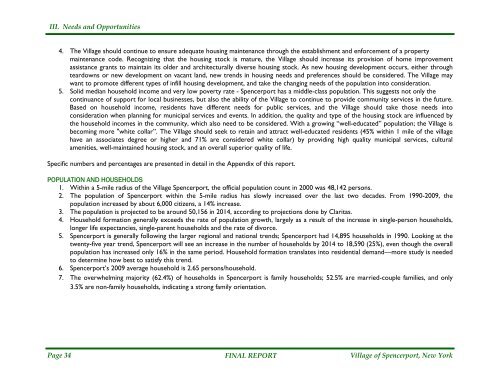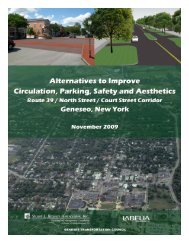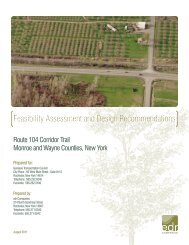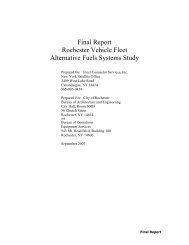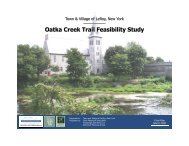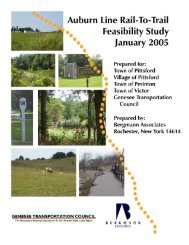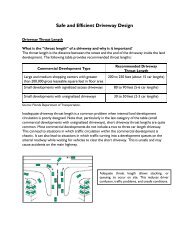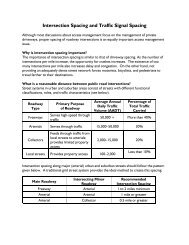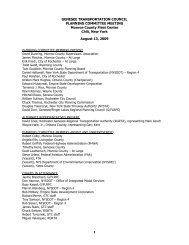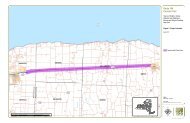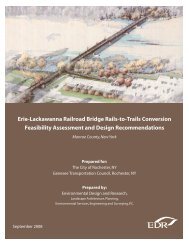Village of Spencerport Eastern Village Corridor Concept Study
Village of Spencerport Eastern Village Corridor Concept Study
Village of Spencerport Eastern Village Corridor Concept Study
Create successful ePaper yourself
Turn your PDF publications into a flip-book with our unique Google optimized e-Paper software.
III. Needs and Opportunities<br />
4. The <strong>Village</strong> should continue to ensure adequate housing maintenance through the establishment and enforcement <strong>of</strong> a property<br />
maintenance code. Recognizing that the housing stock is mature, the <strong>Village</strong> should increase its provision <strong>of</strong> home improvement<br />
assistance grants to maintain its older and architecturally diverse housing stock. As new housing development occurs, either through<br />
teardowns or new development on vacant land, new trends in housing needs and preferences should be considered. The <strong>Village</strong> may<br />
want to promote different types <strong>of</strong> infill housing development, and take the changing needs <strong>of</strong> the population into consideration.<br />
5. Solid median household income and very low poverty rate - <strong>Spencerport</strong> has a middle-class population. This suggests not only the<br />
continuance <strong>of</strong> support for local businesses, but also the ability <strong>of</strong> the <strong>Village</strong> to continue to provide community services in the future.<br />
Based on household income, residents have different needs for public services, and the <strong>Village</strong> should take those needs into<br />
consideration when planning for municipal services and events. In addition, the quality and type <strong>of</strong> the housing stock are influenced by<br />
the household incomes in the community, which also need to be considered. With a growing “well-educated” population; the <strong>Village</strong> is<br />
becoming more "white collar”. The <strong>Village</strong> should seek to retain and attract well-educated residents (45% within 1 mile <strong>of</strong> the village<br />
have an associates degree or higher and 71% are considered white collar) by providing high quality municipal services, cultural<br />
amenities, well-maintained housing stock, and an overall superior quality <strong>of</strong> life.<br />
Specific numbers and percentages are presented in detail in the Appendix <strong>of</strong> this report.<br />
POPULATION AND HOUSEHOLDS<br />
1. Within a 5-mile radius <strong>of</strong> the <strong>Village</strong> <strong>Spencerport</strong>, the <strong>of</strong>ficial population count in 2000 was 48,142 persons.<br />
2. The population <strong>of</strong> <strong>Spencerport</strong> within the 5-mile radius has slowly increased over the last two decades. From 1990-2009, the<br />
population increased by about 6,000 citizens, a 14% increase.<br />
3. The population is projected to be around 50,156 in 2014, according to projections done by Claritas.<br />
4. Household formation generally exceeds the rate <strong>of</strong> population growth, largely as a result <strong>of</strong> the increase in single-person households,<br />
longer life expectancies, single-parent households and the rate <strong>of</strong> divorce.<br />
5. <strong>Spencerport</strong> is generally following the larger regional and national trends; <strong>Spencerport</strong> had 14,895 households in 1990. Looking at the<br />
twenty-five year trend, <strong>Spencerport</strong> will see an increase in the number <strong>of</strong> households by 2014 to 18,590 (25%), even though the overall<br />
population has increased only 16% in the same period. Household formation translates into residential demand—more study is needed<br />
to determine how best to satisfy this trend.<br />
6. <strong>Spencerport</strong>’s 2009 average household is 2.65 persons/household.<br />
7. The overwhelming majority (62.4%) <strong>of</strong> households in <strong>Spencerport</strong> is family households; 52.5% are married-couple families, and only<br />
3.5% are non-family households, indicating a strong family orientation.<br />
Page 34 FINAL REPORT<br />
<strong>Village</strong> <strong>of</strong> <strong>Spencerport</strong>, New York


